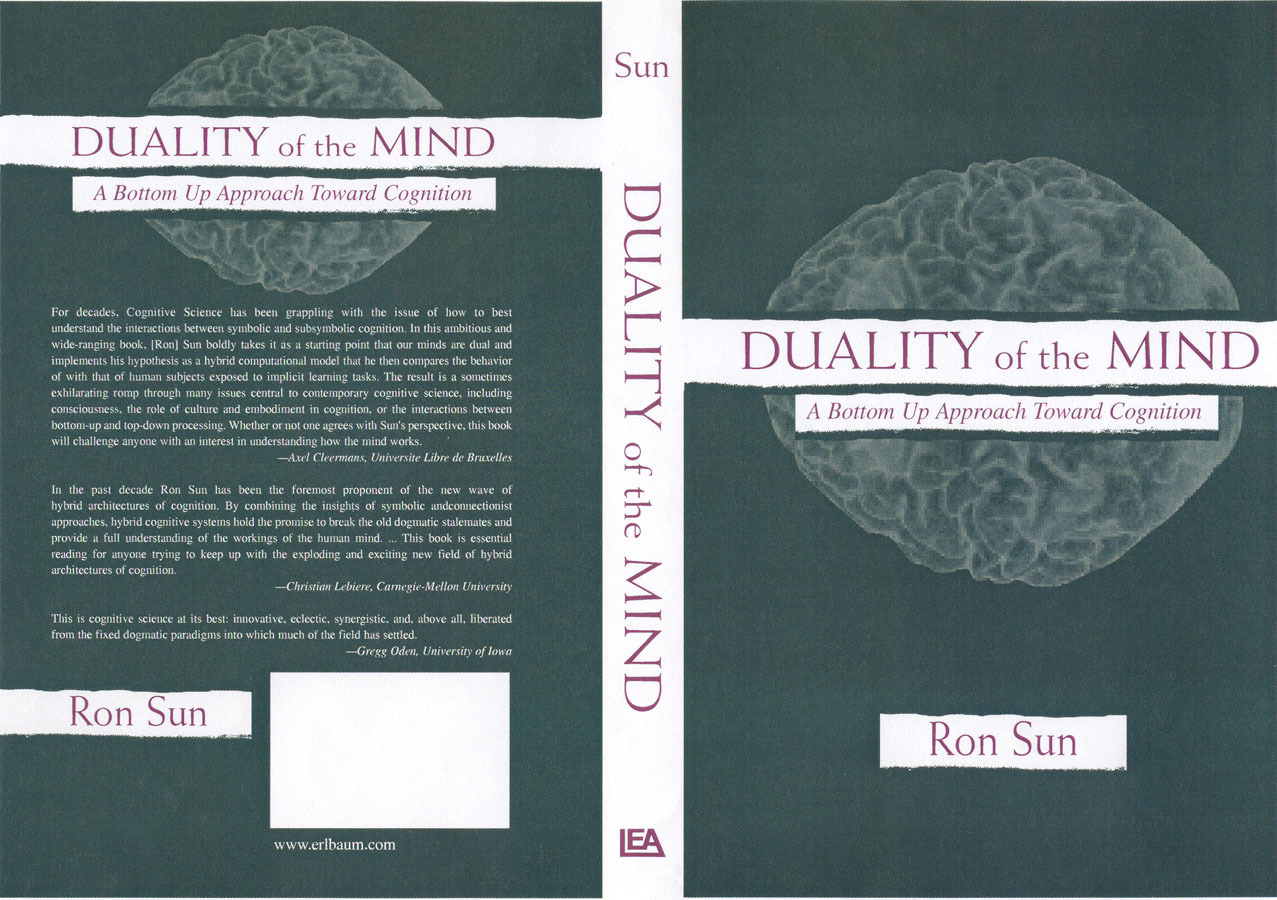

The architecture is tested against a wide range of human learning performance data. The work described in the book demonstrates the cognitive validity and the power of the architecture, by ways of capturing a wide range of human learning phenomena. Computational properties of the architecture is explored with experiments that manipulate implicit and explicit processes to optimize performance in a range of domains. Finally, philosophical implications of the approach, on situated cognition, intentionality, symbol grounding, and consciousness, are elucidated.
In a nutshell, this book motivates, describes, and develops a broad framework for studying human cognition, based on a new approach that is characterized by its focus on the dichotomy of, and the interaction between, explicit cognition and implicit cognition.
This work can be of significant interest to a broad range of readers.
For example, it can be of interest to lay readers having an interest in
issues such as general principles of cognition, foundations of consciousness,
or, more specifically, the role of skill learning in cognition, and so
on. It can also be of interest to researchers and students of cognitive
science, in that some general principles and frameworks, as well as their
instantiations in computational models, may have significant bearings on
the understanding of cognition, and to those of artificial intelligence,
in that many models developed here (and the fundamental principles embodied
in them) may be of use beyond modeling cognitive processes in particular
domains and may be of use in understanding and developing intelligent systems
in general.
See also the book page at
http://www.erlbaum.com/
Acknowledgements
Chapter 1. The Essentials of Human Activities
1.1. Characteristics of Human Activities
1.2. Past Work on Human Activities
1.3. Pitfalls of Representation
1.4. Importance of Learning
1.5. A Broad Theory
1.6. Plan
1.7. Summary
Chapter 2. A Theoretical Model
2.1. Desiderata
2.1.1. \bf Implicit vs. Explicit Knowledge
2.1.2. The Interaction of Implicit and Explicit
Knowledge
2.1.3. Bottom-Up Learning
2.1.4. Benefits of Incorporating Two Types of
Knowledge
2.1.5. On-Line Learning
2.2. A Sketch of the Model
2.2.1. Representation
2.2.2. Learning
2.2.3. Combination and Separation
2.2.4. Summary of Basic Theoretical Hypotheses
2.3. Summary
Chapter 3. Current Implementations
3.1. Reinforcement Learning
3.2. Rule Extraction
3.3. Combining Value Functions and Rules
3.4. Plan Extraction
3.5. Modularity through Spatial Partitioning
3.6. Modularity through Temporal Segmentation
3.7. Biological Interpretations
3.8. Summary
Chapter 4. Accounting for Human Data Qualitatively
4.1. Dissociation
4.2. Division of Labor
4.3. Bottom-Up Learning
4.4. Differences in Representation of Resulting
knowledge
4.5. Differences in Accessibility of Resulting
Knowledge
4.6. Differences in Flexibility, Generalizability,
and Robustness
4.7. Initiation of performance
4.8. Knowledge Interaction
4.9. Synergy
4.10. Summary
Chapter 5. Accounting for Human Data Quantitatively
5.1. Introduction
5.2. Simulating Serial Reaction Time Tasks
5.2.1. Simulating Lewicki et al (1987)
5.2.2. Simulating Curran and Keele (1993)
5.3. Simulating Process Control Tasks}
5.3.1. Simulating Stanley et al (1989)}
5.3.2. Simulating Berry and Broadbent (1988)
5.4. Simulating High-Level Cognitive Skill Learning
Tasks
5.5. Simulating the Minefield Navigation Task
5.6. Discussions
5.6.1. Other Effects
5.6.2. Factors in Division of Labor
5.6.3. Why Synergy in the Model?
5.6.4. Uniqueness of the Model
5.7. Summary
Chapter 6. Symbol Grounding and Situated Cognition
6.1. Introduction
6.2. Symbols and Representation
6.2.1. Symbols
6.2.2. Representation
6.2.3. Intentionality
6.3. Everyday Activities and Symbol Grounding
6.3.1. Comportment
6.3.2. Conceptual Processes and Representation
6.3.3. A Dual Process Theory
6.4. Computational Analysis of Everyday Activities
6.4.1. Computational Processes of Comportment
6.4.2. Computational Processes of Conceptual
Processing
6.4.3. Concept Formation
6.5. Representation and Intentionality
6.6. Further Discussions
6.7. Summary
Chapter 7. The Issue of Consciousness
7.1. Introduction
7.2. Explaining Consciousness
7.2.1. Different views
7.2.2. Analysis of Different Views
7.2.3. Further Evidence and Arguments
7.3. Functional Roles of Consciousness
7.3.1. Access Consciousness
7.3.1.1. An Analysis
7.3.1.2. Computational Account
7.3.2. Reflective Consciousness
7.3.2.1. An Analysis
7.3.2.2. Computational Account
7.3.3. Phenomenal Consciousness
7.3.3.1. An Analysis
7.3.3.2. Computational Account
7.4. Summary
Chapter 8. Sociocultural Factors in Cognition
8.1. Introduction
8.2. Aspects of Sociality
8.2.1. Sociality
8.2.2. Society
8.2.2.1. Social Structures
8.2.2.2. Culture
8.2.2.3. Social Determinism?
8.3. Sociocultural Processes and Cognition
8.3.1. Inter-Agent Processes
8.3.2. Social Processes
8.4. Cognitive Modeling Incorporating Sociocultural
Issues
8.4.1. Autonomous Generation of Symbolic Structures
8.4.2. Assimilation of Externally Provided Symbolic
Structures
8.4.3. Sociocultural vs.\ Self-Generated Concepts
8.4.1. Accounting for Sociocultural Cognition
8.4.2. Representing Self and Others
8.4.2.1. Developing Self Representation
8.4.2.2. Developing Representation of Others
8.5. Further Work
8.5.1. Simulating Social Processes
8.5.2. Individual Beliefs and Sociocultural Beliefs
8.5.3. Inter-Agent Interaction
8.5.4. Forming Social Structures
8.5.5. Social Structures in Cognition
8.6. Summary
Chapter 9. Comparisons
9.1. Cognitive Models Involving Implicit Learning
9.1.1. Process Differences of the Two Levels
9.1.2. Connectionist Modeling of the Simulated
Skill Learning Tasks
9.1.3. Connectionist Modeling of Other Tasks
9.1.4. Non-connectionist Modeling of Skill Learning
Tasks
9.2. Top-down vs.\ Bottom-up Models
9.3. Cognitive Architectures
9.4. Objections and Responses
9.4.1. One Level or Two?
9.4.2. Need for Symbolic Representation
9.4.3. Verification of Explicit Knowledge
9.4.4. Hybridization
9.4.5. Free Parameters?
9.5. Models of Consciousness
9.6. Computational Issues
9.6.1. Models of Rule Learning
9.6.2. Models of Planning
9.6.3. Models of Spatial Partitioning
9.6.4. Models of Temporal Partitioning
Chapter 10. Conclusions
10.1. The Major Theme
10.2. Methodological Considerations
10.3. Cognitive Implications
10.4. A Final Summary
References
To order, go to
http://www.erlbaum.com/
Or,
Lawrence Erlbaum Associates, Inc.
10 Industrial Avenue
Mahwah, NJ 07430,
USA
Tel: 201-258-2200
Fax: 201-236-0072
Go to
Prof. Ron Sun's Homepage